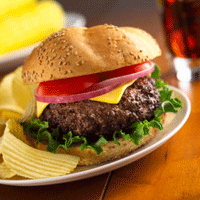It’s often been said: “don’t mess with a good thing,” and the foodservice operators on F&H’s annual Top 100 took that to heart in 2012. In fact, the top foodservice performers kept a balanced approach and realized gross sales of $29.4 billion. In response to moderate sales growth and cautious consumer optimism, the “Top 100” peak performers, which represent approximately 45 per cent of the country’s foodservice market, have been introducing menu favourites with a twist and value deals designed to encourage more traffic.
Perhaps nothing better captures this capitalize-on-a-classic theme than poutine. The Québécois favourite, far from being relegated to cliché status, is being embraced by chain restaurant operators across the country.
Poutine’s appearance on Canadian chain restaurant menus surged 43 per cent from the first quarter of 2012 to the first quarter of this year, from 160 items on 63 restaurants’ menus to 229 items on 77 menus, according to Menu-Monitor, Technomic’s online menu-tracking resource. And, how restaurants are touting their versions of the comfort-food smorgasbord is telling. This year, Jack Astor’s introduced the Pulled-Pork Not Your Routine Poutine; Kelsey’s describes its new Potato Wedge Poutine as “Kelsey’s Twist on a Canadian Classic;” and Eggspectation’s Classic Poutine is described as “Our Take on Quebec’s Classic Late-Night Staple.”
Indeed, across dayparts, menu parts and industry segments, one of the top themes to emerge in Canadian foodservice is to take what the consumer knows well and offer it done better. Beyond the rise of poutine, standout trends include better beverage choices, (more) better burgers and more barbecue.
Better burgers, better beers
Seeking to take their burger-and-a-beer programs up a notch, Canadian casual-dining chains in particular have expanded their beer menus, focusing on craft and premium beers and introducing more specialty burgers.
In fact, craft and premium beer offerings at Canadian casual-dining chains were up 33 per cent in the first quarter of 2013 compared to the same period a year earlier. One chain that sought to highlight its craft selections was Casey’s Grill + Bar, which promoted its fall seasonal menu as providing the perfect pairing for “six carefully selected Ontario craft beers.” Mr. Mikes is taking a slightly different tack by touting exclusive in-house offerings; its beer menu features two brands brewed specially for Mr. Mikes by the Delta, B.C.-based Okanagan Spring Brewery.
Continued burger innovation is appearing on casual-dining menus in the form of non-beef patties, additional proteins, out-of-the ordinary cheeses and boldly flavoured toppings. But, new burgers added in 2012 included Turtle Jack’s Muskoka Grill’s Apple and Brie Burger; the autumn-appropriate item featured a burger patty brushed with apple butter, topped with brie cheese and julienned apples and finished with Dijon mustard, baby spinach, tomatoes and red onion. Crabby Joe’s introduced a Smokin’ Maple Chipotle Burger, with maple-chipotle sauce, smoked gouda and crispy onion strings on an asiago-and-jalapeño bun. In 2013, Brewsters Brewing Company & Restaurant debuted an Aussie Lamb burger, featuring a lamb patty, barbecue sauce, goat cheese, mint mayo, pickled red onion and green leaf lettuce. And, East Side Mario’s introduced its Fat Tony burger, which tops a traditional beef patty with smoked pulled pork, barbecue sauce and provolone cheese.
Limited-service restaurants, too, boosted their selections of bolder burgers. Last summer, McDonald’s Canada rolled out the limited-time offer Angus Third Pounder Smoky BBQ Bacon burger. And, in March of this year, Burger King added chipotle versions of the Whopper and Whopper Junior (as well as chipotle chicken sandwiches) featuring Monterey Jack cheese, jalapeño, bacon, caramelized onions and chipotle sauce.
Right on ’cue
East Side Mario’s Fat Tony shows the rise of barbecued pork — and pulled pork, especially — on menus. Canadian diners are growing more familiar with this regional specialty, and pork is increasingly appealing to operators as a lower-cost alternative to beef, which had high prices in 2012. The number of pulled-pork entrées on Canadian chain restaurant menus surged to 60 in the first quarter of 2013 from 34 a year earlier — an increase of 76.5 per cent.
Interestingly, pulled pork’s popularity is growing across dayparts and menu segments. White Spot offers a Santa Fe Breakfast Burrito with Pork, featuring Canadian pulled pork, scrambled eggs, sautéed tomatoes and green peppers wrapped in a whole-wheat tortilla. Last year, Boston Pizza added pulled-pork pizza, topped with whisky barbecue sauce and baked with mozzarella and red onions. Finally, Montana’s Cookhouse recently introduced pulled-pork nachos and pulled-pork sliders, while Burger King Canada debuted a limited-time-only BBQ Pulled Pork Sandwich.
Adult-focused beverages without the alcohol
On the beverage side, innovation isn’t limited to alcohol offerings. For example, exotic teas and tea-based beverages (such as chai tea lattes) are appealing to health-seekers, while signature smoothies are positioned as a sweetly refreshing, healthful treat for guests of all ages.
Country Style recently introduced tea lattes in chai, London Fog, green tea and matcha green tea varieties, as well as frozen tea frappes. The specialty-tea market is poised for further growth in the near future, too. In fact, of those consumers who have consumed a specialty tea, 40 per cent say they’re likely to increase their orders of these types of drinks in the next two years, according to Technomic’s 2012 “Canadian Beverage Consumer Trend Report.”
Within the limited-service segment, Burger King went the fruity-and-creamy route with yogurt-based Tropical Mango Smoothies, a limited-time offering introduced for spring. Meanwhile, Tim Hortons and McDonald’s Canada dialed up the frozen-beverage competition. In April, McDonald’s added a limited-time-offer strawberry-mango orange smoothie to its Real Fruit Smoothies lineup and announced a promotion, offering four of the cool treats for $1 each for a snack size. And, Tim Hortons also announced a summer promotion, offering its frozen lemonade and frozen raspberry lemonade as well as an iced coffee and iced latte for $1 each for a small.
As 2013 plays out, look for soft drinks and soft drink-based beverages to take centre stage. In fact, the Canadian Restaurant and Foodservices Association named house-made soft drinks as one of its up-and-coming menu items for 2013, based on a survey of more than 350 professional chefs. Interestingly, soft drinks are number 4 on Technomic’s list of the fastest-growing five types of non-alcohol beverages on Canadian menus.
Seeing double in value deals
When it comes to promoting menus, two-for promotions are proving popular with operators. In the fourth quarter of 2012, McDonald’s Canada’s limited-time offer in December of a two-can-dine-for-$9.98 deal featured two Big Mac Extra Value Meals for the special promotional price. In the casual-dining segment, Applebee’s is promoting its two-for-$25 menu, from which guests can choose one shareable appetizer and two entrées (two-for-$30 entrée options also are available).
Courting convenience-seekers
On the tech side, operators are focusing on ways to make it easier for guests to get their favourite foods. Mobile ordering apps, grab-and-go cases and tap-to-pay technology are gaining traction as restaurant operators seek to deliver convenience to time-pressed guests.
One of the biggest tech developments in foodservice in the past year was Tim Hortons’ introduction of smartphone-based payments. As of November, customers who have a CIBC Visa or CIBC MasterCard and a Rogers smartphone, and who download the CIBC mobile-payment app, can pay for their purchases at thousands of Tim Hortons units across Canada by holding their phone up to a contactless PIN pad. Tim Hortons also rolled out free high-speed Wi-Fi at its restaurants throughout 2012. Not to be outdone, McDonald’s is testing mobile-payment at one of its units in Toronto, trying a similar tap-to-pay service.
Meanwhile, this past January Pizza Pizza launched an app for iPads so customers can create, customize and order their selection (and save it for future reference). Users also can play a Spin-to-Win game that offers the chance to win free menu items with their order.
Socially engaged
Through 2012, and the start of 2013, increasingly chain restaurants have been using social media as a platform for engaging guests in conversation. For example, Jack Astor’s Bar and Grill used Twitter to generate buzz when it hopped on the food-truck bandwagon last fall, launching a 12-day food-truck tour to promote new menu items. The chain accepted requests for truck visits from consumers who tweeted with the #TweetToTaste hashtag; guests who visited the truck could try free samples of three new menu selections.
Facebook was also the platform of choice for chicken specialist St. Hubert in a contest earlier this year to find the chain’s biggest fans. Visitors to St. Hubert’s Facebook page were invited to select one of six phrases describing their feelings about St. Hubert. The options included: “I prefer St. Hubert to my mom’s cooking,” and “I down the sauce like a beverage.” Those who registered for the contest were entered into a draw for a $500 St. Hubert gift card or one of four $25 cards.
And, in March of this year, looking to capitalize on consumers’ social-media photo frenzy, Starbucks introduced the #MyMacchiato Photo Challenge. The contest asked guests to tag their Twitter or Instagram photos — spotlighting a different theme each day for a chance to have the photos published on the Starbucks Canada Facebook page.
Seeking transparency
Social media plays a key role in another foodservice trend: the drive toward being more transparent with guests about ingredients, food sourcing and food preparation. McDonald’s Canada, notably, took to YouTube last year to solicit and answer consumer questions — even tough ones. The company launched an “Our Food, Your Questions” digital platform whereby McDonald’s corporate employees answered, via video, consumer-submitted questions such as “Why does your food look different in the advertising than what it is in the store?” and “Are we supposed to believe your burgers are 100-per-cent beef?” The campaign earned McDonald’s the Marketer of the Year 2012 distinction from Toronto’s Marketing magazine.
Tim Hortons, meanwhile, also devotes an interactive page on its website to its annual Sustainability & Responsibility Report, which details the chain’s environment- and health-related initiatives, goals and accomplishments. Visitors to the page can watch a YouTube video that showcases Tim Hortons’ eco-friendly coffee cup, read a Twitter feed of posts tagged with the chain’s #MakingaTrue Difference hashtag and link to a Facebook poll on travel-mug use (Tim Hortons offers 10 cents off hot beverages for all travel-mug users). The chain’s efforts seem to be resonating as Tim Hortons was named Canada’s highest-rated restaurant chain on social responsibility in 2012, according to Technomic’s Consumer Brand Metrics program.
In the end, 2012 was a year to hail the classics, parade in technology and be open and honest with today’s informed customer who will, no doubt, continue to demand the best in 2013 and onward.
Darren Tristano is EVP of Technomic Inc., a Chicago-based foodservice consultancy and research firm. Christine LaFave Grace is an associate editor with the firm. They can be reached at [email protected] or [email protected].





















